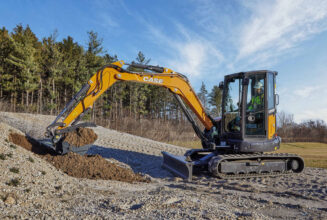How to Build a Spray Park
By Cory Forrest
For safe family fun and heat relief, a community spray park is tough to beat. By following some simple tips, those interested in building a spray park — from designers, architects and engineers to builders, contractors and city planners — can maximize fun and minimize cost.
Start with the end in mind
The key to building a successful spray park is to start with the end in mind. Who is the facility being built for? Defining your users will help determine which features will work best, and if separate play zones are required. For example, designing a spray park that caters to toddlers is very different than designing a park primarily for older kids. If the park will accommodate a range of ages, separate play areas should be considered.
Toddler play zone (ages 1 to 3)
For toddlers, the spray park is a world of discovery as they explore the sights and sensations of water. An abundance of soft sprays and bubblers can delight them,
and proper placement of the water features can bring their experience to life.
Since toddlers enjoy steady, predictable sprays, avoid surprise sprays or quick bursts of water. To promote interactivity and maximize play value, upright features should be appropriate for this age group’s height requirements. For best results, ensure that ground sprays are within 24 inches of each another at varied heights from 6 to 24 inches. This will allow toddlers to approach larger sprays as their confidence builds.
Medium-action play zone (ages 4 to 10)
The medium-action play area is all about maximizing fun. This play area is often the busiest part of the spray park because it’s typically where most of the central play features are installed.
Features in this area should encourage social interaction, and the design should promote both independent and group play. If the budget allows, consider a large structure, like a slide, to serve as a landmark and attract kids and families to engage one another. Musical features and character themes also work well here.
To help make the play zone accessible to children of all physical abilities, arched and looped base spray features that are spacious enough to accommodate wheelchairs should be placed in this area. Another great way to maximize play value and stretch your budget is to fill unused areas of your park with ground sprays to create exciting pathways between water features.
High-action play zone (ages 10 and up)
Unlike the lower action play zones, swiveling water cannons and cooperative play elements will dominate this area. Features can also be further apart as older kids require more space to run around the park.
Faster-actuating ground sprays and interactive programming are required to keep older kids engaged and returning to the park. A large dumping bucket structure is a great focal point for this area, and cause-and-effect or cooperative components should be included to promote interactivity and mental stimulation.
It’s important that this zone does not interfere with the toddler and medium-action play zones, as it may intimidate younger park goers. For this reason, the high-action play zone is best featured near the outside of the spray pad.
Think theme and design
What message or feeling do you want to convey to your spray park audience? This is an important consideration and part of park goers’ overall experience.
Custom themes are a great way to reach out to kids and the community, and can help make one spray park design more memorable than another. It can be as simple as adding a corporate logo to distinguish key financial contributors; as organic as enhancing the surrounding environment; or as exciting as designing an entire facility around a key inspiration with 2D and 3D creatures, characters, colors and sounds that support the vision.
Although custom themes come with a price tag, there are many low-cost ways to create a park theme. For example, try a line of pre-themed spray features, or get creative with custom graphics. But whatever your spray park theme, be sure the overall design and layout encourages maximum play value in a safe, accessible environment.
Add site amenities
To help the community enjoy the spray park to its fullest, adding amenities can increase park usage and may even generate revenue. For example, a washroom or shower facility can help families change clothes and clean up, so they can stay longer in more comfort. For sun protection on hot days, adding shade structures over part of the spray park and seating areas can also keep families comfortable and lengthen their stay.
Parents often appreciate having seats outside the spray zone, with a clear view of the spray pad, to keep an eye on their children. The most popular park designs typically include a raised bank along one side of the park, so parents can easily monitor their kids from an elevated vantage point.
For a lucrative, revenue-generating opportunity, consider placing a concession and gift shop near the spray facility. Savvy spray park operators often find that in addition to selling drinks, burgers, and ice cream, they also sell souvenirs, towels, sunscreen, aqua shoes, bathing suits and water diapers.
Have a water strategy
Water depth
Most spray parks are designed so the water drains off the spray pad immediately, making them “zero-depth” play areas. This improves safety, since it eliminates standing water and the risk of drowning. More children can participate because swimming skills aren’t required. Zero-depth spray parks are also good for those on a budget, since they eliminate the need for lifeguards and reduce the amount of ongoing maintenance.
For facilities with standing water, such as wading or beach entry pools, integrating spray features into the design is becoming a common trend. Whether it’s a new or existing pool, incorporating water cannons or dumping buckets adds fun and excitement while accommodating both swimmers and those learning to swim. Depending on the spray features chosen, this can be a low-cost way to enliven a community pool and keep visitors coming back.
Activators
Planning for water use can conserve resources and help a project stay on budget.
Today, most spray parks use controllers and activators to sequence the park’s water flow between various spray features and ensure the park is only running when activated by someone ready to play. This significantly reduces water consumption and adds play value by putting control of the park in the hands of the kids. After pushing the activator, the kids excitedly try to anticipate which features will spray next.
Water management
There are three main water management options that should be evaluated when considering site, budget and time constraints.
1) Potable, drain to waste systems. This is a low-cost option for small spray parks with low water use. Public water sources supply the park’s features, and the used water is drained to the storm/waste water system. This ensures a high-quality water source at all times and reduces the health risks associated with unclean water. However, it also results in colder water, which can be less comfortable depending on seasonal weather and climate. As the water is not re-circulated, this is not a good option for large spray parks or park designers looking to maximize water conservation.
2) Water treatment/re-circulating systems. This is the most common solution for larger parks or areas with strict water policies. As spray parks continue to gain notoriety around the world, water recirculation systems are becoming the standard. Similar to water treatment systems used in pool facilities, water is drained to a holding tank, filtered, then chemically treated and reused in the park. The size and cost of a water treatment system varies depending on the size of the spray park and the number of spray features, as well as their relative flow rates. Water use and the method of disinfection (e.g. chlorine, chlorine plus ultraviolet [UV] light, CO2) will also affect the cost.
3) Retain and reuse systems. Still a relatively new concept in North America, these systems rely on a fresh potable water supply to the park, and drain used water (gray water) to a collection tank for future use. These custom systems take into account the amount of water captured, the amount reused, and how to best distribute it. Filtration is commonly required before re-use, and the treated water is typically used for irrigation or flushing nearby toilets.
Plan for the future
Safety
No matter how big a splash a new spray park makes in the community, it must be safe to be considered a success. For example, water flow rates, surface slope, and drainage should be carefully chosen to eliminate costly refurbishment in the future. Nozzles at ground level should be flush-mounted to prevent trip hazards, and components should be large-diameter stainless steel to discourage grasping, climbing, and vandalism.
Surfacing
The surface of the spray park should also be non-slip and nonporous to prevent injury and bacteria build up. Broom-finished concrete is the preferred choice for its low cost, excellent traction and minimal upkeep. For a unique look that lasts, design techniques such as stamping, acid etching and coloring can improve a concrete surface at a reasonable cost. These options are a great alternative to surfacing a spray park in bright colors and unique designs that cost more and wear out faster than a concrete surface. If done right, the money you save on surfacing can be used to enhance the play value of spray features, to keep kids and families coming back for more.
Budgeting
If staying on budget is a concern, consider options that allow the project to be completed in multiple phases.
For example, the first phase can include all underground infrastructures with removable nozzle caps added to the top of the base flanges. This enables installation of future spray features. The park operates in its first phase with ground sprays, followed by upright features ordered at a later date, to be mounted onto the base flanges. Another plus: this strategy allows features to be easily swapped out with new components, as the budget allows, keeping the spray park new and exciting for repeat visitors.
To minimize maintenance in a spray park, particularly one that is outdoors, unsupervised, or near the ocean, look for features made from stainless steel with superior finish and paint protection. Material that protect against corrosion and ultraviolet light damage that can withstand vandalism should be selected. It is important to use quality products from reputable manufacturers when building your spray park. It may seem like a big expense initially, but will drastically reduce the amount of costly park maintenance and refurbishment that you might need to keep your park running down the road.
Building a spray park is a very rewarding project for everyone involved. With a little planning, park designers can ensure they build a successful spray park that grows with the community and brings a lifetime of joy to all park goers.
Cory Forrest is a product line manager at Waterplay Solutions Corp., a spray park and water treatment system provider based in Kelowna, Canada. He is responsible for product line life cycles, from initial strategic planning through product specification. He can be reached by e-mail at cory.forrest@waterplay.com For additional help with planning, designing, budgeting, installing, or maintaining a spray park, visit www.waterplay.com e-mail info@waterplay.com or call 250-712-3393.


